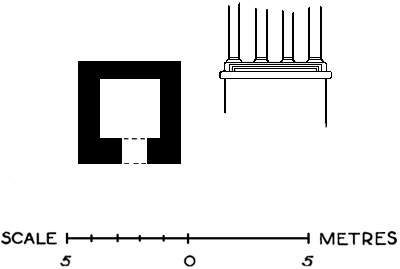
|
ELEVATION SHOWING MOULDINGS.
TELL AHMAR TO BUSEIRAH
Feb. 21--March 7
THE water of the Euphrates is much esteemed by the inhabitants of its banks. It is, I think, an acquired taste; the newcomer will be apt to look askance at the turgid liquid that issues from the spout of his teapot and to question whether a decoction of ancient dust can be beneficial to the European constitution. Fattûh, being acquainted with my idiosyncrasies in the matter of drinking water, accepted without a murmur the sacrilegious decree that that which was destined for my flask must be boiled; whereby, though we did not succeed in removing all solid bodies, we reduced them to a comparative harmlessness. But if it cannot be described as a good table river, the Euphrates is the best of travelling companions, and the revolution of the seasons will never again bring me to the last week of February without setting loose a desire for the wide reaches of the stream and the open levels of the desert through which it flows, the sharp cold of nightfall, the hoar frost of the dawn, and the first long ray of the sun striking a dismantled camp. "There is no road," said Fattûh, "like the road to Baghdâd : the desert on the one hand and the water on the other."
Our way next morning took us past Kubbeh to Mughârah, which we reached in three hours. Here we left the river and climbing the low, rocky hill to the east, found ourselves in a stony and thinly populated country bounded by another ridge of eastern hill. After twenty-five minutes' riding we saw the hamlet of Kayyik Debû about half-a-mile to the left of the track, and in another quarter of an hour we reached a few deserted houses. Four hours from Tell Ahmar / p.36 / we pitched camp on the further bank of a small stream near the village of Serrîn, for I wished to examine two towers which stand upon the crest of a high ridge about half-an-hour to the east. They are called by the Arabs the Windmills, but in reality they are tower tombs. The more northerly, which is the best preserved, in 4'20 m. square and two storeys high (Fig. 20). The walls of the lower storey rise in solid masonry to a height of about six metres and are crowned by a plain course of projecting stones, which serves

|
as cornice (Fig. 21). On the east and west sides, just below the cornice, there is a pair of gargoyles, much weathered. They represent the head and fore-quarters of lions. A little below the pair of heads on the west side is a Syriac inscription, dated in the year 385 of the Seleucid era, i. e. A.D. 74, which states that the tomb was built by one Manu for himself and his sons.1
---------------------------
1 The inscription is given by Pognon: Inscriptions de la Mésopotamie, p. 17. The tomb was visited by Oppenheim, and is mentioned by him in Tell Halaf (1st number, 10th year of Der alte Orient), and in his Griechische und lateinische Inschriften. (Byzantinische Zeitschrift, 1905, p. 7.)
---------------------------
The second storey is decorated with fluted engaged columns, four on either side, the outer pair forming / SERRÎN p.37 / the angles. The bases of these columns rest upon a course of masonry adorned with three fasciae : it is to be noted that the mouldings are not carried straight through to the angles, but are returned one within the other like the mouldings of a door lintel. The Ionic capitals carry a plain Ionic entablature consisting of an architrave with fasciae, which are here taken through to the corners, a narrow frieze and a cyma of considerable projection. Probably the whole was surmounted by a stone pyramid. There are two burial chambers, one in each storey. The lower chamber can be entered by a door in the east wall which was originally closed by a large block of stone. The entrance to the upper chamber, high up in the east wall between the columns, was closed in the same fashion, and the block of porphyry which sealed it is still intact.1
---------------------------
1 Oppenheim thought it was the end of a sarcophagus, but Pognon's guide climbed into the upper chamber and found it to be nothing but a block of stone closing the entrance.
---------------------------
Pognon, who has given the best description and illustrations of the monument, mentions five other examples of tower tombs crowned with pyramids, one of them being the southern tower at Serrîn. The well-known tower tombs of Palmyra and the Haurân are not capped by a pyramid, nor is the face of their walls broken at any point by engaged columns. I believe the type illustrated at Serrîn to be compounded of the simple tower tomb and the canopy, or cyborium, tomb.2
---------------------------
2 For the cyborium tomb, see Heisenburg: Grabeskirche und Apostelkirche, Vol. I. ch. xvi.
---------------------------
The cyborium tomb exists in an infinite number of variations in Syria, in the mountain district near Birejik (whence M. Cumont has supplied me with four examples, three of them as yet unpublished3),
---------------------------
3 A photograph of the fourth, the Ziareh of Khoros at Cyrrhus, was published by Chapot in Le Tour du Monde, April 8, 1905, p.162.
---------------------------
in Asia Minor and in the African Tripoli. Sometimes the columns stand free,4
---------------------------
4 Mylasa : published by the Dilettanti Society; Tripoli : Nouvelles Archives des Missions, Tome XII. fas. I; Dana : De Vogüé, La Syrie Centrale, plate 78.
---------------------------
sometimes they are engaged in the walls,5 some-
---------------------------
5 Tomb of Absalom, Jerusalem.
---------------------------
/ p.38 / times they are represented only by engaged angle piers,1
---------------------------
1 Gereme : Rott, Kleinasiatische Denkmäler, p. 171; El Bârah : De Vogüé, op. cit. pl. 75.
---------------------------
sometimes by free standing angle piers,2
---------------------------
2 M. Cumont's monuments are of this type and I have seen a fine example at Barâd in N. Syria, also as yet unpublished except for a photograph given by me in The Desert and the Sown, p. 287.
---------------------------
and occasionally column and pier have dropped away and the plain wall alone remains,3
---------------------------
3 Maden Sheher: published by Sir W. Ramsay and myself in The Thousand and One Churches, p. 230.
---------------------------
but the pyramidal roof is an almost constant feature, which, even in the simplest of these tombs, recalls the original canopy type. In the hill side near the tower I noticed several rock-cut mausoleums, now half-choked with stones and earth, and the hill was no doubt the necropolis of a town lying in the low ground that stretches down to the modern village by the stream.4
---------------------------
4 The name which has been suggested for the site is Baisampse, a place mentioned by Ptolemy. There are a considerable number of cut stones on the mound near the village.
---------------------------
The second tower, of which only the south wall remains, is situated on the southern end of the ridge, half-an-hour's ride from the first (Fig. 22). It differs slightly in detail from the other. In the lower storey a shallow engaged pier stands at either angle, while in the upper storey, in place of the porphyry block, there is an arched niche between the two central engaged columns. The fasciae returned at the corners reappear, but the columns are not fluted. The hill top commands a wide view over country which appears to be entirely desert. My guide, who was a Christian from Aleppo, an agent of the Liquorice Trust for the Serrîn district, said that there was no settled population to the east of us, and that the few Arab encampments which were visible upon the rolling steppe were those of the Benî Sa'îd, a subdivision of the Benî Fahl. As we sat in the sunshine under the tower, Jirjî related tales of his neighbours, the Arab sheikhs, for whom he entertained, as the townsman will, feelings that ranged between contempt and fear — contempt for their choice of a black tent in the desert as a dwelling-place, and fear inspired by the authority / KEL'AT EN NEJM p.39 / which they wielded from that humble abode. But chiefly his simple soul was exercised by the swift downfall of Ibrahîm Pasha, who for so many years had been, as the fancy prompted him, the scourge or the mighty protector of all the inhabitants of northern Mesopotamia, a man with whom the government had to make terms, while the great tribes stood in awe of him and the lesser tribes fled at the whisper of his name. Jirjî, like many another, refused to believe that he was dead, and entertained us with wild surmises as to the manner of his possible return from the unknown refuge where he lay in hiding. "God knows he was a brave man," said he. "Oh lady, do you see Kal'at en Nejm yonder?" And he pointed west, where across the Euphrates the walls and bastions of the fortress crowned the precipitous bank. "There be forded, he and eight hundred men with him, when he hastened back from Damascus to his own country, hearing that the government was against him. They swam the river with their horses and rested that night at Serrîn. But the Pasha was grave and silent: God's mercy upon him, for he befriended us Christians." Hâjj 'Alî shook his head. "He wrecked the world," said he. "Praise God he is dead." Somewhere between the two opinions lies the truth. I suspect that though the way in which his overthrow was accomplished left much to be desired the Millî Kurds of whom he was the chief, had gained under his bold leadership a pre-eminence in lawlessness which no government was justified in countenancing. But since he is dead, peace to his memory, for he knew no fear.
We could not see the river from Serrîn, but next morning I rode down to it and looked across to the splendid walls of Kal'at en Nejm. The castle, seated upon a rocky spur, encloses the steep slopes with its masonry until it seems like a massive buttress of the hill, as ageless and no less imperishable than the rock itself. We turned away from this stern ghost of ancient wars and rode from the Euphrates up a bare valley wherein we came upon a great cave, inhabited by a few Arabs. It contained three large chambers, / p.40 / the opening of which had been fenced in by the latest inhabitants with screens made of rushes. Upon one of the walls I found a curious inscription written in characters not unlike those seen by Sachau in a cave near Urfah1 (Fig. 23).
---------------------------
1 It was re-copied by Pognon and published by him in Inscrip. de la Mésopotamie, p. 82. The similarity between some of the characters in the two inscriptions is striking.
---------------------------
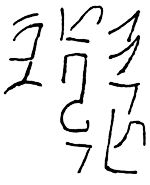
CAVE NEAR SERRÎN
|
---------------------------
1 It appears in the extreme right-hand top corner of his Fig. 22, Inschrif. aus Syrien und Mesopot.
---------------------------
Beyond Mas'ûdîyeh we crossed a long belt of sand, lying in a bend of the river; we left a small mound (Tell el Banât) a mile to the east, climbed a ridge of bare hill and dropped down into a wide stretch of grass country, empty, peaceful and most beautiful. It was enclosed in a semicircle of hills that stood back from the river, and from out of the midst of it rose an isolated peak known to the Arabs as Kuleib. This land is the home of the Weldeh tribe, and not far from the Euphrates we found a group of their tents pitched between green slopes and the broad reaches of sand which give the spot its name, Rumeileh, the Little Sands. It was the encampment of Sheikh Sallâl, and no sooner had we arrived than the sheikh's son, Muhammad, came out to bid us welcome and invite us to his father's tent. The two zaptiehs and I took our places round the hearth while Muhammad roasted and pounded the coffee beans, telling us the while of the movements of the great tribes, where Hâkim Beg of the 'Anazeh was lying, and where Ibn Hudhdhâl of the Amarât, and similar matters of absorbing interest. Sheikh Sallâl was in reduced circumstances by reason of a recent difference of opinion with the government. His brother had been enlisted as a soldier and had subsequently deserted, whereupon the government had seized Sallâl's flocks and clapped the sheikh into gaol, and finally he had sold "the best mare left to us, wallah!" for £T37 and with the money procured his own release.
/ p.42 /
"Eh billah!" said Hâjj 'Alî, shaking his head over the confused tale in which, as is usual in these episodes, the wrongdoing seemed to be shared impartially by all concerned. "Such is the government!"
"And now, oh lady," pursued the sheikh, "we have neither camels nor sheep, for the government has eaten all."
"How do you live?" said I, looking round the circle of dark, bearded faces by the camp fire.
"God knows!" sighed the sheikh, and turning to Hâjj 'Alî he asked him what was this new government of which he heard, and liberty, what was that?
"Liberty?" said Hâjj 'Alî, evading the question; "how should there be liberty in these lands? Look you, they talk of liberty, but there is no change in the world. In Aleppo many men are murdered every week, and who knows what they are doing, those enjoys whom we sent to Constantinople?"
In spite of his misfortunes Sheikh Sallâl designed to entertain me at dinner and had set aside for that purpose an ancient goat. My attention was attracted to it by the sound of bleating in the women's quarters and I was just in time to save its life, expending myself, however, in protestations of gratitude. Muhammad ibn Sallâl took me round the encampment before the light failed and pointed out the foundations of a number of stone-built houses. Behind my tents the summits of some grassy mounds were ringed round with circles of great stones, of the origin of which he knew nothing. I counted five of them; in the largest lay foundations of small rectangular chambers.
As we walked back to the tents Muhammad said reproachfully:
"Oh lady, you have not laughed once, not when I showed you the ruins, nor when I told you the name of the hills."
I hastened to amend my ways, and thus encouraged he enumerated a string of ruined sites in the neighbourhood and accepted an invitation to serve us as guide next morning. He prepared himself for the journey by slipping on four cartridge belts, one over the other, although our whole / MUNBAYAH p.43 / road lay in the Weldeh country, and the worst enemy we encountered was a raging wind which sent the Euphrates sands whirling about us and obscured the landscape near the river. In about an hour we climbed up on to the higher ground of the grass plain at a point called Shems ed Dîn, where among a heap of cut stones I found fragments of an entablature carved with dentils and palmettes. Perhaps the ruins were the remains of a tower tomb. At Tell ez Zâher, an hour further south, we saw heaps of unsquared building-stones. Above this site stood Sheikh Sîn, a steep hill which we ascended, but found no trace of construction on it. I sent my zaptieh down to stop the baggage and bid Fattûh camp at the mound of Munbayah near the river, and with Muhammad turned inland to a hill called by him Jernîyeh, some five miles to the east. Muhammad rode across the downs at a hand gallop in the teeth of the wind, and I behind him, too much buffeted by the storm to call a halt. The immediate reason for our haste, as I presently discovered, was a couple of pedlars from whom he desired to buy soap, a commodity of which he stood in great need. The two men were Turks; they greeted me with effusion as a fellow alien in those wastes, and at parting pressed upon me a handful of raisins with their blessings. We galloped on faster than before and arrived breathless at Jernîyeh which lifts its solitary head a hundred feet or more above the surrounding plain. On the summit are three large mounds into which the Arabs had dug and uncovered fine cut stones; I conjecture that there may have been here watch towers or tower tombs belonging to the town of which the ruins lie below, to the south of the hill. These ruins comprise a large low mound ringed round with a wall and a ditch, and a considerable area covered with remains of buildings made of unsquared stones. Occasionally the plan of house or court was marked out upon the grass and Muhammad showed me several deep cisterns — altogether a very remarkable ruin field though it is not named on Kiepert's map. On our way back to the river we climbed Tell el Ga'rah and found the foundations of a fort on the top of it. Here we picked up a much- / p.44 / weathered Byzantine coin and a quantity of sherds of glazed Arab pottery, blue and green and purple. Munbayah, where my tents were pitched — the Arabic name means only an elevated spot — has been conjectured to be the Bersiba of Ptolemy's catalogue of place names. It is an irregularly-shaped double enclosure, resting on one side on the river (Fig. 25). The line of the walls is marked by high grass mounds, but here and there a bit of massive polygonal masonry, large stones laid without mortar, crops out of the soil. The outer enclosing wall is not continued along the north side, but ends in a heap of earth and stones which looks like the ruins of a tower or bastion. To the south there is a clearly-marked gate in the outer wall, corresponding with a narrower opening in the inner line of fortification; another gate leads out to the north, and facing the river there are traces of a broad water gate, protected on either side by a wall that drops down the slope towards the stream (Fig. 26). Twenty minutes further down the bank lies another mound, Tell Sheikh Hassan. There are vestiges of constuction by the water's edge between the two mounds, and south of Tell Sheikh Hassan the ground is broken by a large stretch of ruin mounds, among which I saw a rude capital. In another half-hour down stream, at 'Anâb, there is again an enclosure of grassy heaps strewn with stones. For a distance of about three miles, therefore, the left bank of the river would seem to have been inhabited and guarded, though possibly at different dates. Jernîyeh and Munbayah are by far the most interesting sites which I saw on the little-known stretch of the river between Tell Ahmar and Kal'at Ja'bar; it is useless to conjecture in what way, if at all, they were connected with each other, but in both places I should like to clear away the earth and see what lies beneath.
If it had been possible to cross the Euphrates I would have examined the high tell of Sheikh 'Arûd which had been all day the fixed point for my compass, but though there was a boat to be had, the intolerable wind continued till nightfall and made the passage impracticable. The mental exasperation produced by wind when you are living and
/ MUNBAYAH p.45 /
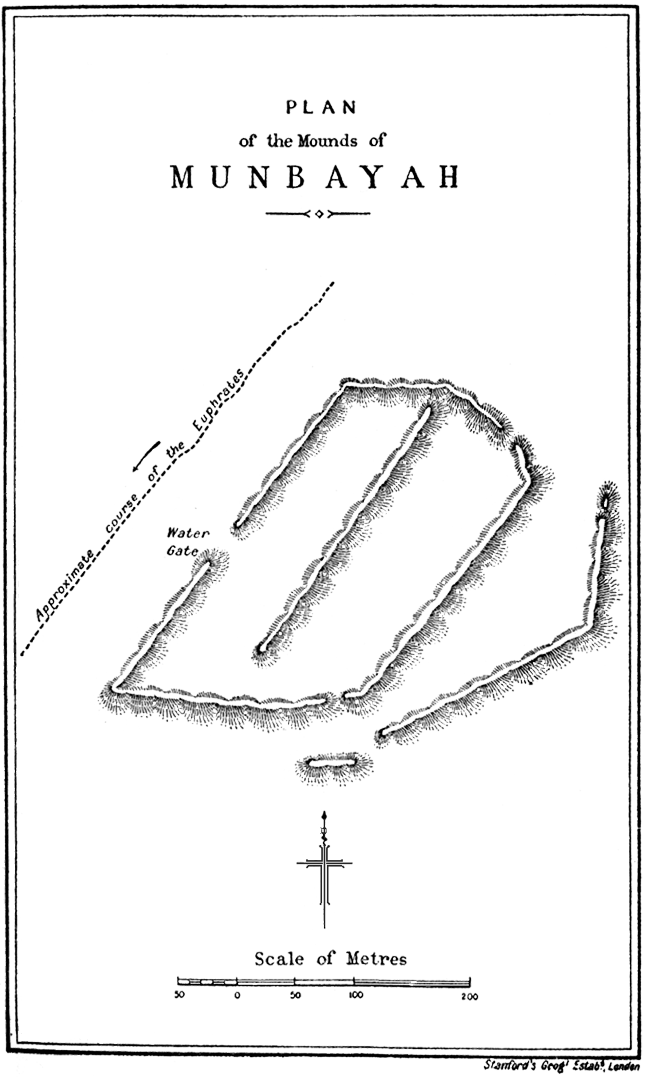
|
/ p.46 / trying to work out of doors, passes belief. The blast seizes you by the hand as you would hold your compass steady, dances jigs with your camera and elopes with your measuring tape and when after an exhausting struggle you return vanquished to your tent, it is only to find your books and papers buried in sand. Moreover, commissariat arrangements were complicated by the interruption of communications with the opposite side of the river. Fortunately I had foreseen that there would be little food for man or beast on the left bank, where no travellers pass, and contrary to my habits had laid in a provision of tinned meats, for which we had reason to be thankful. The baggage animals were lightly loaded and could carry four days' corn besides their packs; when this ran short Fattûh went foraging in every Arab encampment, but occasionally the horses were without their full allowance, for at this time of the year the Arabs themselves are very scantily supplied. We soon learnt to place no reliance on assurances, however emphatic, that the next sheikh down the river would be well furnished, and as our road led us into regions that had suffered more and more severely from the lack of rain, we gave up all hope of ekeing out our corn with the grass which never grew that year. The corn, too, became dearer, until at Baghdâd it touched famine prices. On the upper parts of the river there is no fuel and we carried charcoal for cooking purposes; but when the tamarisk bushes began to appear, about a day's march north of Rakkah, the muleteers boiled their big rice pot over a fire of sticks and the zaptiehs warmed their hands in the sharp chill of the early morning at the heap of embers that had been kept alive all night. The zaptiehs are supposed to feed themselves, but except on the rare occasions when we were on a high road, they shared the meals of my servants. I would find them sitting in the dark round the steaming dish served up by Hâjj 'Amr, and with them the Arab who had been our guide that day, or one who had dropped in towards supper time to give us information of the road, or any aged person considered by Fattûh to be worthy of our hospitality. We held many a frugal feast
[ Illustration opposite p.46 ]
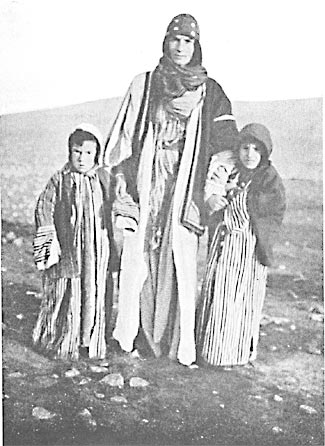
|
[ Illustrations opposite p.47 ]
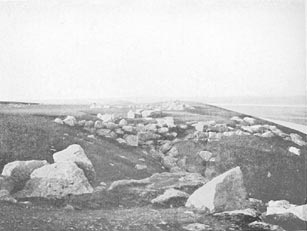
|
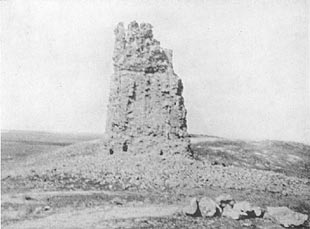
|
/ DIBSEH p.47 / under the stars where the waters of the Euphrates roll through the wild.
During the next day's ride we followed the course of the river closely, save where the grassy edge of the desert was separated from the water by a tract of sand and stones covered in time of flood, and therefore devoid of all trace of settled habitation. The tents of the Weldeh were scattered along the banks and occasionally a small bit of ground had been scratched with the plough and sown with corn. At one point we saw the white canvas tent of a man from Aleppo who was engaged in negotiating an amicable partnership with the Weldeh sheikhs. The majestic presence of the river in the midst of uncultivated lands, which, with the help of its waters, would need so little labour to make them productive, takes a singular hold on the imagination. I do not believe that the east bank has always been so thinly peopled, and though the present condition may date from very early times, it is probably that there was once a continuous belt of villages by the stream, their sites being still marked by mounds. Half-an-hour from 'Anâb we passed Tell Jifneh, with remains of buildings about it; in another hour and a half there were ruins at Hallâweh, and forty minutes further we came to a big mound called Tell Murraibet. From this point the grass lands retreated from the Euphrates, leaving place for a wide stretch of sand and scrub opposite Old Meskeneh. Kiepert marks two towers on some high ground to the east, but they must have fallen into ruin since Chesney's survey, for I could not see them. Six hours from Bersiba we reached in heavy rain the tents of Sheikh Mabrûk and pitched our camp by his, so that we might find shelter for our horses under his wide roof. We were about opposite Dibseh, which was perhaps the famous ford of Thapsacus. Mabrûk told me that in summer, when the water is low, camels can cross the river just above Dibseh; at Meskeneh a ferry boat is to be had, but at no other point until you come to Rakkah.
Next morning a young man from the sheikh's tent, cousin to Mabrûk (all the unmarried youths of the sheikh's family / p.48 / are lodged in his great house of hair) rode with us to Kal'at Ja'bar. He told me of a ruin called Mudawwarah (the Circle), an hour and a half away to the east: it may represent one of Kiepert's towers, but according to Ibrahîm's account nothing is now to be seen but a heap of stones. We rode out of the camp with a troop of women and children driving donkeys into the hills, where they collect brushwood.
"Last year," said my companion, "they dared not stray from the tents, lest the horsemen of Ibrahîm Pasha should attack them and seize the donkeys. Wallah ! the children could not drive out the goats to pasture, and every man sat with his loaded rifle across his knees and watched for the coming of raiders. For indeed he took all, oh lady; he robbed rich and poor; he held up caravans and killed the solitary traveller."
"Eh wah!" said the zaptieth, "and the soldiers of the government he killed also. He was sultan in the waste."
"But now that he is gone," continued Ibrahîm, "We are at rest. And as soon as we heard of his death we blessed the government, and all the men of the Weldeh rode out and seized the flocks that he had captured from us, and more besides. And behold, there they pasture by the river." And he pointed to some sheep grazing under the care of a couple of small boys.
"Then all the desert is safe now?" said I.
"Praise God!" he answered, "for the 'Anazeh are our friends. We have no foes but the Shammar, and their lands are far from us."
Before we reached Kal'at Ja'bar we galloped up into the low hills to see a rock-cut tomb. Through a hole in the ground we let ourselves down into a chamber 5'10m. x 7'00 m., with nine arcosolia set round it, each containing from four to six loculi (Fig. 27). On one of the long sides there was a small rectangular niche between the arcosolia. Ibrahîm called the place Mahall es Safsâf and assured me that it was the only cavern known to him in these hills. From here he took me down to a mound named Tell el Afrai, which lies about a quarter of a mile from the river. On the landward side / KAL'AT JA'BAR p.49 / it is protected by a dyke forming a loop from the Euphrates. At one time the water must have filled this moat,
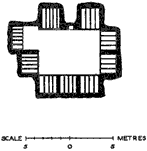
|
|
---------------------------
1 I could not reconcile the topography here with Kiepert's map. He marks a northern tower, which he calls Nesheib (doubtless my Neshabah) and places there the Mazâr of Sultan 'Abdullah. He has a second tower further to the south-east, and finally the castle itself. The second tower is non-existent, or else it represents the minaret in the castle. The only mazâr which I saw or heard mentioned is that of Sultan Selîm, a small modern building between Neshabah and the castle.
---------------------------
Of the Neshabah tower nothing remains but a rectangular core of masonry (unworked stones set in thick mortar) containing a winding stair which can be approached by a doorway about four metres from the ground. Below the door there is a vaulted niche which looks like the remains of a sepulchral chamber. All the facing stones have fallen away, but the core is ridged in a manner that suggests the former existence of engaged columns, and I believe that Neshabah is a tower tomb older than the castle, rather than the outlying watchtower of an Arab fort.2
---------------------------
2 It resembles the tower tombs at Irzî, which will be described later.
---------------------------
The buildings at Kal'at Ja'bar are mainly of brick, though some stone is used in the walls and bastions that surround the hill-top (Fig. 29). The entrance is strongly guarded; from the outer gate-house a long narrow passage, hewn out of the rock, leads into the interior of the / p.50 / castle. Among the ruins within the walls are a vaulted hall and parts of a palace composed of a number of small vaulted chambers. The construction of the small vaults struck me as having stronger affinities with Byzantine than with the typical Mesopotamian systems, and I should not assign to them a very early date. The palace had also contained a hall of some size, but only the south wall is standing (Fig. 31). It is broken by a deep recess, possibly a mihrâb, with a doorway on either side, and the upper part is decorated with a row of flat trifoliate niches. In the centre of the castle a round minaret rises from a massive square base (Fig. 30). Towards the top of the minaret there is a double band of ornamental brickwork with a brick inscription between. I could not decipher the inscription, owing to its great height, but the characters were not Cufic, and the round shape of the minaret makes it improbable that it should be earlier than the twelfth century. Beyond the minaret is a vaulted cistern. The shelving north-west side of the hill is defended by a double ring of brick towers, but on the south-east side, where the rocks are precipitous, there is little or no fortification. The brick walls of the buildings above the gate-way are decorated with string courses and bands of diamond-shaped motives, the diamonds set point to point or enclosed in hollow squares (Fig. 32).
The history of the castle is not easy to disentangle from the accounts left by the Arab geographers. An earlier name for it was Dausar, but even this does not seem to have been applied before the seventh century, though Idrîsî, writing in the twelfth century, ascribes its foundation to Alexander. He is the first author who mentions Dausar and he gives no authority for his statement as to its origin. Opposite Dausar, on the right bank of the Euphrates, stretches the battlefield of Siffîn, where in A.D. 657 the Khalif 'Alî entrusted his ally Nu'mân, a prince of the house of Mundhir, with the defence of these reaches of the Euphrates, and that a servant of the latter, Dausar by name, built the castle which was called after him. It took its present name from an Arab of the Kusheir, from whose sons it was wrested (in A.D. 1087)
[ Illustrations opposite p.50 ]
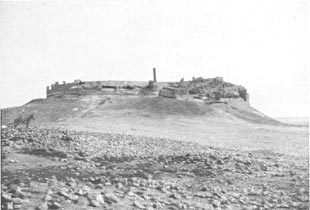
|
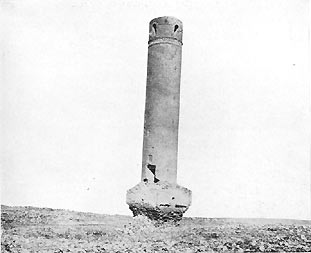
|
[ Illustrations opposite p.51 ]
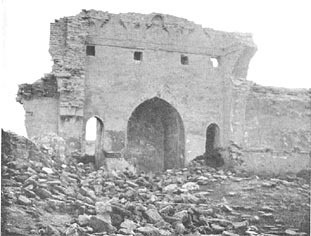
|
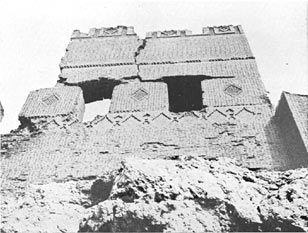
|
/ KAL'AT JA'BAR p.51 / by the Sultan Malek Shah, the Seljuk.1
---------------------------
1 This is Abu'l Fidâ's account, ed. Reinaud, p.277. He wrote in A.D. 1321. Yâkût, a century earlier, gives the same story.
---------------------------
It was held by the Franks of Edessa during the first Crusade and captured by the Atabeg Nûr ed Dîn towards the middle of the twelfth century. It passed into the hands of the Ayyûbids, and in Yâkût's time (1225) was held by Hâfiz, the nephew of Saladin. Benjamin of Tudela says that he found a colony of 2,000 Jews settled at Ja'bar, which was then a much-frequented ferry.2
---------------------------
2 Quoted by Ritter, Erdkunde, Vol. X. p. 241.
---------------------------
I did not observe any signs of habitation outside the castle, except a few caves in the rocks to the south; but half-an-hour further down the river, on a bluff called Kahf (Chahf in the Bedouin speech) ez Zakk, there are traces of houses which may represent the Jewish settlement. In Abu'l Fidâ's day (fourteenth century) the castle of Ja'bar was ruined and abandoned. The greater part of the existing buildings might well have been erected by Nûr ed Dîn, and failing further evidence it is to him that I should ascribe them.
Under Kahf ez Zakk we found the tents of Hamrî, one of the principal sheikhs of the Weldeh, a sturdy white-bearded man in the prime of age, with the fine free bearing of one long used to command. He sat in the sunshine and watched the pitching of our camp, ordering the young men of the tribe to bestir themselves in our service, one to gather brushwood, another to show the muleteers the best watering-place on the muddy river-bank, a third to fetch eggs and sour curds, and when he had seen to our welfare, he strode back to his tent and bade me follow. The coffee was ready when I arrived, and with the cups the talk went round of desert politics and the relation of this sheikh with that all through the Weldeh camps. The glow of sunset faded, night closed down about the flickering fire of thorns, a crescent moon looked in upon us and heard us speaking of new things. Even into this primeval world a rumour had penetrated, borne on the word Liberty, and the men round the hearth fell to discussing the meaning of those famous syllables, which have no meaning save to those who have lost that for which they stand. But / p.52 / Sheikh Hamrî interposed with the air of one whose years and experience gave him the right to decide in matters that passed the common understanding.
"How can there be liberty under Islâm ?" said he. "Shall I take a wife contrary to the laws of Islâm, and call it liberty? God forbid." And we recognized in his words the oldest of the restrictions to which the human race has submitted. "God forbid," we murmured, and bowed our heads before the authority of the social code.
On the following day a dense mist hung over the valley. An hour from Kahf ez Zakk the path left the Euphrates at a spot called Mahârîz where there are said to be ruins, but owing to the fog I could see nothing of them.1
---------------------------
1 Ainsworth believed this to be the site of Benjamin of Tudela's Jewish settlement (Euphrates Expedition, Vol. I. p. 269), and he speaks of a monastic ruin here.
---------------------------
Three quarters of an hour later we returned to the river and rode under low cliffs in which there were caves; my guide called the place Kdirân, which is, I suppose, Kiepert's Ghirân. Here again we left the water's edge, and half-an-hour later the fog melted away and revealed a monotonous green plain with the camels of the Weldeh pasturing over it. In summer it is a favourite camping-ground of the 'Anazeh. At Billânî, three and a half hours from our starting-point, we rejoined the Euphrates. Billânî is visible from afar by reason of a number of bare tree-trunks set in the ground to mark the Arab graves which are grouped about the resting-place of some holy man. The ancient sanctity of the place is still attested by numerous shafts of columns among the graves, but seventy years ago Chesney could make out a small octagonal temple.2
---------------------------
2 It is so described in his map.
---------------------------
It was a fine site for temple or for tomb. The river comes down towards it through many channels in the shape of a great fan, gathers itself into a single stream, broad and deep, and so sweeps under the high bank on which the fragments of the shrine are scattered, and beyond it round a wide bend clothed with thickets of tamarisk and thorn and blackberry. Through these thickets we rode for two hours and a half, and
[ Illustrations opposite p.52 ]
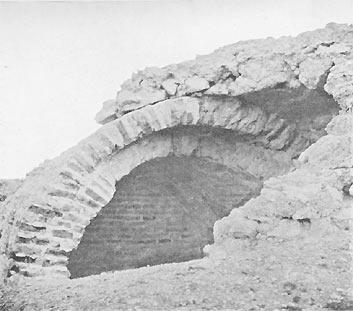
|
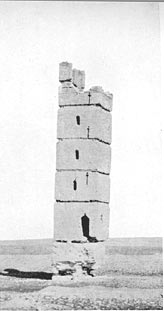
|
[ Illustrations opposite p.53 ]
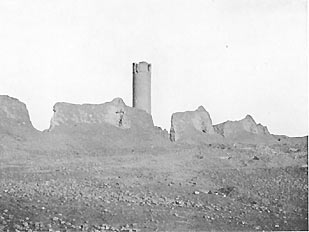
|
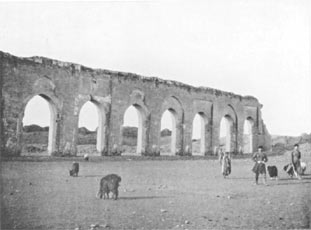
|
/ HARAGLAH p.53 / then camped under a mound called Tell 'Abd 'Alî, not far from a couple of very poor tents of the Afâdleh, with the river a mile away. The night was exquisitely still, but from time to time an owl cried with a shrill note like that of a shepherd-boy calling to his flocks.
Our camp proved to be but two hours' ride from Rakkah. A little more than half-way between the two places we reached the enigmatic ruin which is known to the Arabs as Haraglah, a name which may be a corruption of Heraclea. It consists of a rectangular fortress, almost square, with a series of small vaulted chambers forming the outer parts of the block and, as far as I could judge, larger vaulted chambers filling up the centre (Fig. 33). At the four angles there are round towers. The building
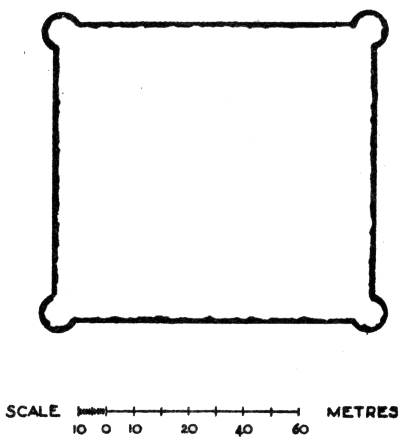
|
as it now stands is merely a substructure, a platform resting on vaults, on which stood an upper storey that has disappeared. The masonry is mostly of unsquared stones laid in a bed of very coarse mortar mixed with small stones, but the vaults are of brick tiles, and it is noticeable that these tiles are not laid in the true Mesopotamian fashion, whereby centering could be dispensed with (i.e. in narrow slices leaning back against the head-wall), but that the double ring of tiles is treated like the voussoirs of a stone arch and must have been built on a centering (Fig. 34). This structure would be enough to show that the work does not belong to the Mohammadan period. The fortress is ringed round by an outer wall, now completely ruined. Beyond it to the south runs a dyke, and beyond the dyke, some 500 m. south-east of the central fort, there is another mound on which I saw cut stones larger than the stones used at Haraglah. Still further / p.54 / to the south lies a third mound, Tell Meraish, with a second dyke to the south of it. The two dykes appeared to be loop canals from the Euphrates and must therefore have formed part of an extensive system of irrigation; probaby [lit.] there had once been a considerable area of cultivation under the protection of the fortress.1
---------------------------
So we came to Rakkah and there joined forces with the army of Julian, who had marched down from Carrhae and the head waters of the Belîkh 1,500 years ago and more — the account of the march given by Ammianus Marcellinus is, however, irreconcilable with the facts of geography, for he says that Julian reached Callinicum in one day from the source of the river Belias, whereas it is at least a two days' journey. Callinicum was not the earliest town upon the site of Rakkah, though the record of history does not go back further than to its immediate predecessor, Nicephorium, which some say was founded by Alexander and others by Seleucus Nicator. When Julian stopped there to perform the sacrifice due at that season to Cybele, Callinicum was a strong fortress and an important market. Chosroes, a couple of hundred years later, finding it insufficiently guarded, seized and sacked it. Justinian rebuilt the fortifications but in A.D. 633, according to Abu'l Fidâ, it fell to the Mohammadan invaders. In A.D.772 the Khalif Mansûr strengthened the position with a second fortified city, Râfikah (the Comrade), built, it is said, upon the same round plan as Baghdâd, which was another city of his founding. Hârûn er Rashîd built himself a place either in Rakkah or in Râfikah, and used the place as his summer capital. In the subsequent centuries the older foundations fell into ruin and the Comrade, which continued to be a flourishing town, usurped its name, so that in Yâkût's day (1225) the original Rakkah had disappeared, but Râfikah was known as Rakkah. Here is fine matter for confusion among the Arab geographers, and they do not fail to make the most of it. White Rakkah, Black Rakkah, Burnt Rakkah, and no / RAKKAH p.55 / less than two Middle Rakkahs figure upon their pages, and it is impossible to determine whether any or none of these titles stands for Râfikah, or which of them denotes the old Rakkah. But by 1321 when Abu'l Fidâ wrote, all the Rakkahs were reduced to uninhabited ruin (perhaps by the Mongol horders of Hûlâgû), and it only remains for the traveller to collect the names of sites, which his Arab guide will furnish with an alacrity that runs ahead of accuracy, and apply them as he thinks best to the list of recorded towns. And lest I should fail to add my quota to the tangled nomenclature, I will hasten to state that at a distance of an hour and ten minutes east of the ruins that lie about the modern village, I rode over a large stretch of ground on which there were traces of habitation and was told that its name was Brown Rakkah — (Rakkat es Samrâ) — and on further inquiry I learnt that nearer to the Euphrates there was a similar area called Red Rakkah — Rakkat el Hamrâ) — but as I neglected to visit the spot I need not do more than mention that Kiepert marks Black Rakkah — (Rakkat es Saudâ) — at about the place where it must be.
---------------------------
It is obvious that the stone must have been brought from elsewhere, since the inscription cannot refer to the insignificant structure on which it is placed. In the adjoining graveyard there are many fragments of columns, presumably taken from the mosque, and some much battered capitals, one of them worked with acanthus leaves. I saw, too, a small marble double column of the type so common in the early Christian churches of Asia Minor.
---------------------------
1 Sachau thought that Haraglah was of Hellenistic origin (Reise in Syrien und Mesopotamien, p. 245); Sarre believes that it may be Parthian, and the circular outer fortification gives colour to the suggestion (Zeitschr. der Gesell. für Erdkunde zu Berlin, 1909, No. 7).
---------------------------
To come to matters less controvertible, the modern Rakkah consists of two villages, of which the westernmost has recently been erected by a Circassian colony upon high broken ground that certainly indicates the existence of an older settlement. Beyond it to the east there is a large semi-circular enclosure, the straight side turned towards the Euphrates and lying at a distance of about a mile from that river. The walls are built of sun-dried brick alternating with bands of burnt brick, and set at regular intervals with round bastions. There are clear traces of a moat or ditch and of a second, less important, wall beyond it. The Arab village lies in the south-west corner of this enclosure, near the centre are the ruins of a mosque with a round minaret, on the east side the remains of a large building, probably a palace, and at the south-east corner part of a gate called the Baghdâd gate. Still further east there is yet another ruin field. Towards the middle of it rises a square minaret standing in a rectangular space which has been enclosed by walls of sun-dried brick, no doubt a mosque (Fig. 35). The minaret is of brick, but it rests / p.56 / upon a square base formed of large blocks of marble. The brickwork is broken by six horizontal notched rings, the uppermost surmounting a wide band of ornamental brick. The notches in the brick were obviously intended to contain some other material, possibly wood, which has now perished. There are numerous fragments of columns in the neighbourhood of the minaret. The only other buildings are, north of the minaret, a small domed ziyârah, which local tradition would have to be the tomb of Yahyâ el Barmakî, who, as well as his more famous son Ja'far, was vizir to Hârûn er Rashîd, and not far from the Baghdâd gate a similar shrine, known as the Ziyârah of Uweis el Karanî. Uweis fell in A.D. 657 in one of the engagements fought on the Euphrates between 'Alî and Mu'âwiyah, but his tomb is of no great interest except in so far as it is composed of older materials. Over the doorway is an inscription which states that "this fortress and shrine were repaired by Sultan Suleimân, son of Selîm Khân," who reigned from 1526-1574.1
1 Sachau (op. cit. p. 243) gives the inscription, and my copy tallied with his.
---------------------------
It is tempting to suppose that in the eastern ruin field we have the site of the oldest city, Nicephorium-Callinicum-Rakkah, that the columns were derived from Hellenistic or Byzantine buildings and re-used in a mosque of which nothing now remains but the square minaret.2 I think it not
2 Just as the first mosque in Cairo, that of 'Amr, was built entirely on columns taken from earlier buildings,Mukaddasî describes one of the Rakkah mosques as ![]() ; it would be satisfactory to imagine that he referred to the columned arcades of the mosque round the square minaret, but the phrase cannot reasonably be twisted into that or any other meaning. The square minaret is the ancient Syrian tower type; Thiersch has recently published an exhaustive study of it in his Pharos.
; it would be satisfactory to imagine that he referred to the columned arcades of the mosque round the square minaret, but the phrase cannot reasonably be twisted into that or any other meaning. The square minaret is the ancient Syrian tower type; Thiersch has recently published an exhaustive study of it in his Pharos.
---------------------------
[ Illustrations opposite p.56 ]
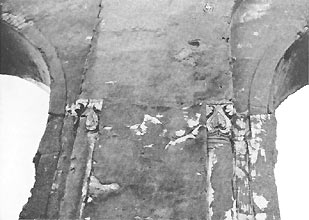
|
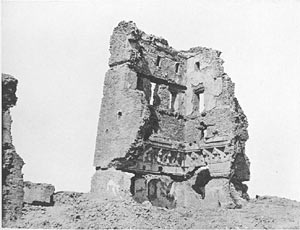
|
[ Illustrations opposite p.57 ]
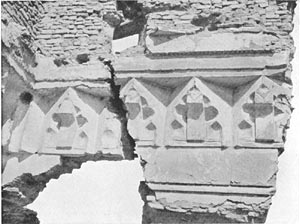
|
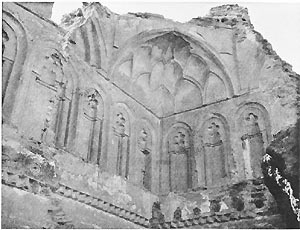
|
/ RAKKAH p.57 / improbable that the semi-circular enclosure represents Mansûr's foundation, Râfikah, though it does not follow that any of the existing ruins, except perhaps parts of the wall, belong
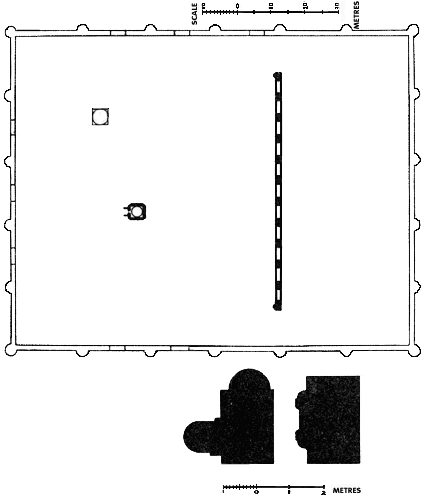
|
FIG. 36.—RAKKAH, PLAN OF MOSQUE AND SECTIONS OF PIERS.
to his time. They are nevertheless of great importance in the history of Mohammadan art. The mosque is surrounded by a wall of sun-dried brick broken by round bastions (Fig. 36). In the centre of the sahn, or court, there is a small ziyârah / p.58 / recently rebuilt, and in the north-east corner the round brick minaret springs from a square stone base composed of ancient materials (Fig. 37). The upper part of the minaret is decorated with bands of brick dog-tooth ornament. One of the great arcades which enclosed the sahn still stands on the south side (Fig. 38).1
---------------------------
1 I saw traces of two such arcades on the E., N. and W. sides of the court, and, judging from the vestiges that remain, the arcades must have been three deep to the south. The bricks of the vanished arcades have been dug out and carried away for building purposes. The outer walls are so much ruined that I could not determine the position of the gates with certainty.
---------------------------
An inscription over the central arch states that the mosque was repaired by the Atabeg Nûr ed Dîn in 1166, and I conjecture that the minaret is of his building.2
---------------------------
2 Professor van Berchem has published the inscription in his Arabische Inschriften, a chapter appended to the work of Professor Sarre and Dr. Herzfeld entitled Reise in Euphrat- und Tigris-Gebiet. But the publication has appeared too late for me to do more than refer to it.
---------------------------
The mosque is of the true Mesopotamian type, of which the most famous examples are the two mosques at Sâmarrâ and the mosque of Ibn Tûlûn at Cairo. With all these it shows the closest structural affinities, and it may be assumed that Nûr ed Dîn retained the original plan when he repaired the building. The stucco capitals of the engaged columns on the piers belong to the same family as the elaborate stucco ornaments of Ibn Tûlûn, which date from the latter half of the ninth century, and in both cases the decorative motives employed are probably Mesopotamian in origin (Fig. 39). Stucco decorations are also the main feature of the group of palace ruins near the east wall. The most noticeable of these is a rectangular tower-like structure (Fig. 40), where the chamber on the ground-floor shows bold stucco ornament on which are traces of colour (Fig. 41). On the walls of another chamber of the palace, which was covered with a dome set upon squinch arches, there is a row of arched niches, the arch being cusped on the inside. Below the niches is a brick dog-tooth string-course (Fig. 42). The squinches contain a primitive stalactite motive. There are two other small rooms, both of which are roofed with an oval dome (3'87 m. x 3'32 m.
[ Illustrations opposite p.58 ]
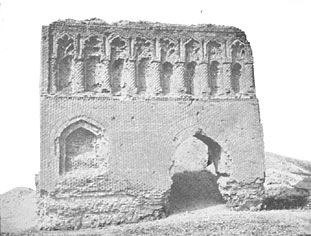
|
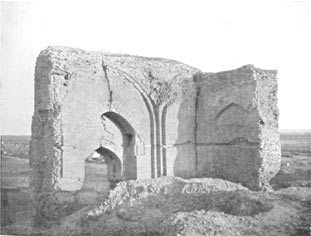
|
[ Illustration opposite p.59 ]
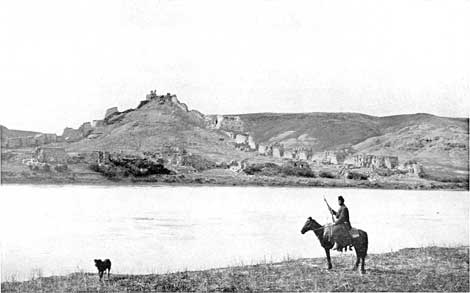
|
/ RAKKAH p.59 / and 4'02 m. x 2'03 m.); in both cases the dome is very shallow and the rectangular substructure is adapted to the oval by means of wooden beams laid across the angles. Everywhere wooden beams were used in conjunction with brick, and it is to be borne in mind that though the country round Rakkah is now entirely devoid of trees, all the Arab geographers speak of the well-wooded gardens and groves of fruit-trees that surrounded the town. In the tower-like building and in the Baghdâd gate bands of wood were laid in the face of the wall, but the wood has perished, leaving the space it occupied to tell of its former presence, as in the eastern minaret. The cusp motive can be seen in the blind arcade on the exterior of the Baghdâd gate (Fig. 43). In the interior
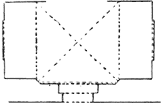
GATE, RECONSTRUCTED.
|
---------------------------
1 M. Viollet has published a short description of these ruins (Publications de l'Académie des Inscip. et Belles-Lettres, 1909, Vol. XII. part 2). He believes the palace to have been erected by Hârûn er Rashîd.
---------------------------
The whole of the two areas of ruin are strewn with potsherds of the Mohammadan period, and over the greater part of the walled city the ground is honeycombed with irregular holes and trenches, the excavations of peasants in search of the now celebrated Rakkah ware. A few years ago their labours were rewarded by a large find of unbroken pieces, many of which made their way through the hands of Aleppo / p.60 / dealers to Europe, and though such a stroke of good fortune is rare, perfect specimens are occasionally unearthed, and I saw a considerable number, together with one or two fragments of exquisite glass embossed with gold, during the two days I spent at Rakkah. In some instances the original factories and kilns have been brought to light, and it is not unusual to see bowls or jars which have been spoilt in the baking and thrown away by the potter. No exhaustive study of Rakkah ware has as yet been made, though it is of the utmost importance in the history of the arts of Islâm. The fabrication of it must have reached a high state of perfection during the twelfth and thirteenth centuries, to which period the pieces which have been preserved are usually assigned.
At Rakkah matters fell out in a way which, if they had not been handled firmly, might well have wrecked my plans, for a telegram arrived from the Vâlî of Aleppo directing all whom it might concern to put a stop to my progress down the left bank of the Euphrates, on account of the disturbed condition of the desert. The Vâlî commanded that I should be turned back across the river and conveyed carefully from guardhouse to guardhouse along the high road. It was the Mudîr of Rakkah who was ultimately responsible for the execution of these orders, and he, honest man, was much perplexed when he discovered that one side of the Euphrates was not the same to me as the other, nor was he helped to a better understanding when I explained that I preferred the Jezîreh, the Mesopotamian bank, because no one travelled there. The Shâmîyeh, the Syrian bank, he hastened to assure me, was also chôl (wilderness), if that was what I desired, and he begged me to believe that I should find the guardhouses most commodious. Thereupon I took up the question on a different issue, and called his attention to the fact that the Vâlî, who was newly appointed to Aleppo, could not have heard how peaceful the desert had become since the death of Ibrahîm Pasha. The Mudîr admitted the truth of this observation, and we compromised by sending a telegram to the Vâlî, asking him to reconsider his decision. But the telegraphic system of the Turkish empire leaves an ample / JEBEL MUNÂKHIR p.61 / margin for the exercise of individual discretion in emergencies, and since upon the third day no reply had been received, I was spared from showing a direct disregard of official dictates, while the Mudîr, seeing my caravan set out towards the Belîkh, wisely made the best of a bad business and sent a couple of zaptiehs with me. One of them was a Circassian who had little Arabic, but the other, Mahmûd by name, proved an agreeable and intelligent fellow-traveller, well informed, and a keen politician.
It is exactly two hours' ride from Rakkah to the Belîkh. Our path lay between stretches of marsh, which must always have existed hereabout, for the word Rakkah means a swamp. Where we crossed the Belîkh it was a muddy brook, almost all the water having been drawn off for irrigation purposes, and the bridge was merely a few bundles of brushwood laid upon some poles. I sent the caravan down the bank of the Euphrates and taking one of my zaptiehs with me, turned slightly inland towards a group of hills called Jebel Munâkhir, the Nebs. In about two hours we reached a small outlying limestone tell on the top of which there were traces of masonry. Jebel Munâkhir, a mile or so from the tell, is an extinct volcano, and the lava beds extend almost to the tell. We climbed to the summit of the mountain and found the crater to be a distinctly marked basin with broken sides. On one of the peaks there is a ziyârah, a square enclosure made of undressed stones piled together without mortar, and a small tomb-chamber of the same construction. I looked carefully for any trace of ancient work, but my search was rewarded only by finding clumps of pale blue irises growing among the rocks. The west massif of Jebel Munâkhir, on which we were standing, rises several hundred feet above the level of the plain, and we had an extensive view over the unknown desert to the north. About three miles to the east lay another but smaller block of hill called Jebel Munkhar esh Sharkî, the Eastern Neb, and on the horizon, almost due north, we could see some rising ground which my guide, an Arab of those parts, stated to be Jebel 'Ukala.1 Below it there are
---------------------------
1 I expect that this is Sachau's Bergland Tulaba — see Kiepert's map.
---------------------------
/ p.62 / wells, and another well, Abu Tutah, lies between it and the Belîkh. Between Jebel Munâkhir and Jebel 'Abdu'l 'Azîz (which I could not see) there is a low ridge of hill, Jebel Beidâ. All through this desert country there are small wells of water (jubb is the Arabic word) sufficient to supply the 'Anazeh, who pasture their flocks here during the spring; I saw a few of their encampments, but the greater part of the tribe was still in winter quarters further to the east and south. The tents along the river were those of the 'Afadleh — 'Ajeil el Hamrî is the chief sheikh of the tribe, but I did not happen to meet him. An hour's ride from the hills we reached a large encampment at a spot called Kubûr ej Jebel, near the Euphrates. The name means the Graves of the Mountain, but I could not hear of any tombs in the neighbourhood. Our own tents were pitched an hour further down on some grassy mounds by the river far from any Arabs; Meida, my guide called the place. In the low ground between Kubûr ej Jebel and Meida, but above flood-water level, we crossed an area ringed round with a notable deep ditch. Somewhere near my camp Julian must have received his Arab reinforcements. On leaving Nicephorium, he marched along the bank of the Euphrates, "and at night he rested in a tent, where some princes of the Saracen tribes came as suppliants bringing him a golden crown and adoring him as master of the world, and of their own nations. . . . While he was addressing them," pursues Ammianus Marcellinus,1
---------------------------
1 Bk. XXIII. ch. iii. 8.
---------------------------
"a fleet arrived as large as that of the mighty lord Xerxes; . . . they threw a bridge over the broades part of the Euphrates. The fleet consisted of one thousand transports bringing provisions and arms, and fifty ships of war, and fifty more for the construction of bridges. . . ." At this point a hubbub arose in the servants' tents; the golden crowns and the battleships went tumbling on to the grass, and I ran out just in time to see a troop of little shadowy forms hurrying in the moonlight across the sands by the water's edge. They were wild pig, the only herd we encountered.
It is essential to have a local man by you if you would / ABU SA'ID p.63 / ascertain local names (even then the nomenclature is apt to be confusing), and accordingly I took an Arab with me next morning. We rode in five minutes to a grassy mound by the river, Khirbet Hadâwî, in another quarter of an hour to Khirbet ed Dukhîyeh, and in twenty minutes more to Jedeideh. At none of these places did I see any trace of construction, but at Abu Sa'îd, ten minutes further, there is an 'Anazeh mazâr with graves round it marked by fragments of columns and small basalt mills for grinding corn. It would be interesting to know from what period these mills date; I saw quantities of them in the burial-grounds between Munbayah and Tell Murraibet, but none of the Arabs know what they are, and when they find them they use them as tombstones. At Abu Sa'îd we turned away from the river and rode inland in a north-easterly direction. The great bare levels were more than usually enchanting that morning; the hot sun beat upon them; a sharp little wind, the very breath of life, swept across them, and all the plain was aromatic with sweet-scented plants. Presently we passed a few 'Anazeh tents, and I stopped and gave the aristocracy of the desert a respectful salutation. An inmate of the tents, hearing my greeting, picked up his spear, mounted his mare and bore us company for a mile or two; I do not know what dangers he expected to encounter or whether the spear was merely for sheref (honour), but when time hangs as heavy as it does in an Arab tent, you may as well put in the hours by carrying a spear about the countryside as in any other manner. We engaged in an exceedingly desultory conversation, in the course of which he called out to me:
"Lady, my mare is sick."
"God cure her," said I.
"Please God!" he returned. "It is her mind — her mind is sick." But I could suggest no remedy for that complaint, whether in man or beast.
When he left us, the zaptieh and I began to talk of the prospects of good administration under the new order. Mahmûd was by birth a Turk, a native of Kars, whence he had migrated when it fell into the hands of the Russians. / p.64 / His long acquaintance with the Arabs had only served to enhance in his estimation the Turkish capacity for government, and the granting of the constitution had raised it yet higher. "The Turks understand politics," said he, "and look you, the constitution was from them. But as for the Arabs, what do they know of government?" He placed great confidence in the Young Turks, and said that every one except the effendis was in favour of the dastûr (the constitution). "The effendis fear liberty and justice, for these are to the advantage of the poor. But they, being corrupt and oppressors of the poor, set themselves in secret against the dastûr, and because of this we have confusion everywhere. And if one of them is sent to Constantinople as a deputy his work will not be good, for he will work only for himself. And in the vilayets there will be no justice unless the English will send into each province an overseer (mufattish) who will look to it that the dastûr is carried out. Effendim, do you see my clothes?" I examined his ragged nondescript attire; save for the torn and faded jacket it would have been difficult to recognize in it a military uniform. "Twice a year the government gives us clothes, but they never reach us at Rakkah. The officers in Aleppo eat them, and with my own money I bought what I wear now."
"Are you paid?" I inquired.
"The government owes me twenty-four months' pay," he answered.
I asked what he thought of the scheme for enlisting Christians.
"Why not?" said he. "The Christians should help the Moslems to bear the burden of military service." And then he added, "If there be no treachery."
There was no need to ask him what he meant by the last phrase. I had heard too often from the lips of Christians the expression of a helpless fear that the new régime must founder in blood and anarchy, after which the nations of Europe would step in, please God, and take Turkey for themselves. This forecast was not by any means confined to the Christians, but they, of all others, should have refrained / TELL ESH SHA'ÎR p.65 / from putting it into words, for it did not encourage patriots like Mahmûd to believe in their loyalty.
We reached our goal, Tell esh Sha'îr, in two hours and forty minutes from Abu Sa'îd, but the time in this case represents about twelve miles, since we were not riding at caravan pace. There were no buildings on the tell, but a number of large stones had been dug out of it and set up as a landmark — rijm, the Arabs call such guiding stone heaps. Two shepherds of the 'Anazeh joined us while we were at lunch, much to their material advantage, for we shared out provisions with them; from them I learnt that there had once been a well here, but that it was now choked up. They knew of no ruins in the desert beyond, and my impression is that there has never been any settled population in this region, away from the Euphrates. We struck back to the river in a south-easterly direction, and in three hours came to our camp, pitched by some Afadleh tents on a mound of which I have not recorded the name. It is the boundary between the kazas of Rakkah and of Deir, and lies about an hour's march below a site called by Kiepert the Khân. From our camp we rode in an hour to the ruins of Khmeidah, where there were vestiges of a considerable town, squared stones, baked brick walls and a stone sarcophagus. An Arab on a broken-down mare joined us here, and as we rode together Mahmûd described to me the nature of the authority exercised by the government over the tribes, and particularly the incidence of the sheep-tax.
"Effendim," said he, "you must know that the government levies the sheep-tax from each sheikh." Four piastres per head of sheep is the amount. "And the scribe having computed the number of sheep that belong to those tents, he calls upon the sheikh to make good the sum due, and perhaps the sheikh will have to pay 2,000 piastres. Then he levies from the men of his tents 3,000 piastres, and to the government he gives 1,800."
"True, true," said the Arab beside us. "Wallah, so it is."
"And then," pursued Mahmûd, "another man is sent out by the government, with his clerk and half-a-dozen of us zaptiehs. And all this costs much money. And the sheikh / p.66 / levies another 500 piastres, and pays 150 piastres; and so it goes on till the sum is found, but the expenses of collection are heavy. And as for the tax on cultivated land, the owner gives a bribe to him who is sent to value it, and he estimates the produce at less than half the real amount. And so it is with the sheep-tax. Effendim, do you think that all the sheep are counted? No, wallah! Last year the cornlands of the Shâmîyeh between Rakkah and Deir paid only £800, and the sheep-tax in the Jezîreh was no more than £2,000."
"Eh yes," said the Arab, "but the government takes much."
"The sheikhs take much," returned Mahmûd. "Oh Ma'lûl, is it not true that they levy a tax for themselves on every tent?"
"Eh wallah!" said the Arab.
"Allah, Allah ! he knows the truth," cried Ma'lûl in vociferous approval.
"And they have no protection," concluded Mahmûd.
"Eh wah !" responded the Arab, "who is there to protect us?"
So the ancient tyrannies bear sway even in the open wilderness.
Three-quarters of an hour from Khmeidah we passed another mound strewn with potsherds, and thirty-five minutes further down we came upon the ruins of Abu 'Atîk. They lie upon high rocky ground that drops steeply into an old bed of the Euphrates from which the river has retreated into a new bed a few hundred yards away. The whole area is covered with stone and brick foundations, some of them built of great blocks of hewn basalt, and the site must represent a city of no small importance. Below it the river is forced into a narrow defile where it flows between steep hills. A little valley, Wâdî Mâlih, joins the main stream half-an-hour from the ancient town, and it was here that we were overtaken by a breathless zaptieth from Rakkah who was the bearer of the answer to my telegram to the Vâlî of Aleppo. It was a / ZELEBÎYEH p.67 / refusal, politely worded, to my request that I should be permitted to travel down the left bank of the Euphrates and with it came a covering letter from the Mudîr of Rakkah saying that if I did not return he would be obliged to recall the zaptiehs he had sent with me. I fear that even those who cannot properly be numbered among the criminal classes catch an infection from the lawless air of the desert, but whatever may be the true explanation of our conduct, we never contemplated for a moment the alternative of obedience, and bidding a regretful farewell to friend Mahmûd, we went on down the defile. Mahmûd came galloping back to give us a final word of advice. "Ride," said he, "to Umm Rejeibah, where you will find a kishlâ (a guardhouse), but do not camp to-night in a solitary place, for this is the country of the Baggârah, and they are all rogues and thieves."
The Euphrates, gathered into a single channel, flows very grandly through the narrow gorge. At first the hills slope down almost to the water's edge, but afterwards they draw back and leave room for a tract of level ground by the stream. An hour and a half from Wâdî Mâlih the valley widens still more, and on the opposite bank the great castle of Halebîyeh lifts its walls from the river almost to the summit of the hill, a towered triangle of which the apex is the citadel that dominates all the defile (Fig. 46).1
---------------------------
1 It was visited and planned by Sarre and Herzfeld in 1907; Sarre, Reise in Mesopotamien, in the Zeitschrift der Gesch. für Erdkunde zu Berlin, 1909, No. 7, p. 429. Sarre pronounces the greater part of the ruins to date from the time of Justinian.
---------------------------
Twenty minutes lower down, the Mesopotamian bank is crowned by the sister fortress of Zelebîyeh. It is a much less important building. The walls, set with rectangular towers, enclose three sides of an oblong court; the fourth side — that towards the river — must also have been walled, and it is probable that the castle approached more nearly to a square than at present appears, for the current has undermined the precipitous bank and the western part of the fortifications has fallen away. The masonry is of large blocks of stone, faced on the interior and on the exterior of the walls, while the core is mainly of rubble / p.68 / and mortar. There are six towers, including the corner bastions, in the length of the east wall, and between the two central towers is an arched gate. On the north and south sides there is now but one tower beyond the corner. Each tower contains a small rectangular chamber approached by an arched doorway. The court is covered with ruins, and on either side of the gate there is a deep arched recess. Under the north side of the castle hill there are foundations of buildings in hewn stone, but the area of these ruins is not large.
The name Zelebîyeh carries with it the memory of an older title; in the heyday of Palmyrene prosperity a fortress called after Zenobia guarded the trade route from her capital into Persia, and all authorities are agreed that the fortress of Zenobia described by Procopius is identical with Halebîyeh. Procopius states further that Justinian, who rebuilt Zenobia and Circesium, refortified the next castle to Circesium, which he calls Annouca. The Arab geographers make mention of a small town, Khânûhah, midway between Karkîsîyâ (Circesium) and Rakkah,1
---------------------------
1 Ibn Haukal is, I think, the first to speak of it. Idrîsî says that it had busy markets and that much traffic went through it. They wrote respectively in the tenth and twelfth centuries.
---------------------------
and the probable identity of Annouca and Khânûkah has already been observed by Moritz.2
---------------------------
2 Zur antiken Topographie der Palmyrene, p. 39.
---------------------------
But I think it likely that the flourishing mediaeval Arab town was situated not in the confined valley below Zelebîyeh but at Abu 'Atîk, where the ruin field is much larger. It may be that there was a yet older settlement at Abu 'Atîk, and that the stone foundations there belonged to the town of Annouca which stood at the head of the defile, while the castle of the same name guarded the lower end.
We struck across the barren hills and so came down in an hour and half to Kubrâ, a ziyârah lying about a quarter of a mile from the river. There were no tents to be seen, whether of the Baggârah or of any other tribe, and no man from whom we could ask the way; by misfortune we happened to be that day without an Arab guide, and mindful of Mahmûd's parting injunctions, we began to look eagerly / MUNGA'RAH p.69 / ahead for the kishlâ. Some way lower down, the Euphrates swept close under a low ridge which we were obliged to climb, and once on the top we espied Kishlâ el Munga'rah nestling under the further side of the slope. It had taken us two and a half hours to reach it from Zelebîyeh. The kishlâ, which was built ten years ago and is already falling into ruin, was garrisoned by eight soldiers. They gave us an enthusiastic welcome and helped us to pitch our tents under the mud walls of the guardhouse; visitors are scarce, and the monotony of existence is broken only by episodes connected with the lawless habits of the Baggârah. I never came into contact with the tribe, but I was told that, alone among the river Arabs, they had been the allies of Ibrahîm Pasha and were consequently gôm (foes) of the 'Anazeh and their group. Enmities of this kind are usually accompanied by overt acts, and the Baggârah had their hand against every man.
It would be difficult to exaggerate the isolation of the guardhouses which are scattered through remote parts of the Turkish empire. The garrisons receive but a scanty allowance of their pay, and a still scantier of clothing; frequently they are left unchanged for years in the midst of an ungrateful desert where the task assigned to them is too heavy for them to perform — eight men, as the soldiers at Munga'rah observed, cannot keep a whole tribe in check — and where there is no alternative occupation. Often enough I have contemplated with amazement, in some lonely kishlâ or karâghôl, the patient Oriental acceptance of whatever fate may be allotted by the immediate or the ultimate authority; and many an hour has passed, far from unprofitably for the understanding of the East, while a marooned garrison has shown me, with a pitiful and childlike eagerness, its poor little efforts to while away the weary days — here a patch of garden snatched from the wilderness, where only a hand-to-hand struggle with the drifting sand can keep the rows of wizened onions from total extinction; there a desultory excavation in a neighbouring mound, in which if you dig far enough a glittering treasure must surely lie; a captive quail / p.70 / for snaring, warmly pressed upon me for my evening meal, or the small achievements in what may, for want of an exacter term, be called carpentry, with which the living-room is adorned. If you will reckon up the volume of unquestioning, if uninstructed, obedience upon which floats the ship of the Turkish State, you will wonder that it should ever run aground.
The relaxation of the men of Munga'rah was taken among the ruins that covered the top of the hill. Umm Rejeibah is a large area enclosed in a wall, clearly marked by mounds, with a ditch beyond it. On the north side an old channel of the river sweeps under the hill, and before the water left this course, it had carried away a part of the ground on which the city stood. The walls break off abruptly where the hill has fallen away, and it is therefore difficult to determine the exact shape of the enclosure. It appears to have been an irregular octagon. Towards its northern extremity the hill-top is seamed by the deep bed of a torrent draining down to the present channel of the Euphrates; it cuts through the ruins and revels in section what is elsewhere hidden by an accumulation of soil. On the slope of its bank the soldiers had observed traces of masonry, and by digging a little way into the hill had disclosed a small circular chamber with brick walls and a white tesselated pavement. Just above the kishlâ, in an Arab graveyard, there are fragments of columns and basalt flour mills.
The oldest, raggedest and most one-eyed of the garrison accompanied us to Deir: I had not the heart to refuse his proffered escort, since it would enable him to spend a night in the local metropolis. The road was entirely without interest. About an hour from Deir cultivation began on the river bank in patches of cornland irrigated by rude waterwheels; jird is the Arabic word for them. We reached the ferry in six hours. The road from Aleppo to Mosul crosses the Euphrates at Deir, and some ten years ago it was proposed to replace the ferry by a bridge. The work was actually put in hand and has advanced at the rate of one pier a year, according to my calculations; but it can scarcely be / DEIR p.71 / expected that this rate of progress will be maintained, since the point has been reached where the piers must be built in the bed of the stream, and construction will necessarily be slower than it was when the masons were still upon dry ground. We pitched our camp upon the left bank and there spent thirty-six hours, resting the horses and laying in provisions. The bazaars are well supplied, but Deir is not in other respects remarkable. It is first mentioned by Abu'l Fidâ, in A.D. 1331,1
---------------------------
1 The reference is not, however, certain: Moritz, op. cit. p. 35.
---------------------------
and contains, so far as I know, no vestiges of older habitation. It is built partly upon an island; the gardens of this quarter, exactly opposite my camp, were rosy with flowering fruit-trees. None but the richer sort, and such as have flocks to bring over, cross the river in the ferry boats; more modest persons are content with an inflated goat-skin. I had not seen this entertaining process, except on the Assyrian reliefs in the British Museum, and I watched it with unabated zest during the greater part of an afternoon. You blow out your goat-skin by the river's edge, roll up your cloak and place it upon your head, tuck your shirt into your waistcloth and so embark, with your arms resting upon the skin and your legs swimming in the water. The current carries you down, and you make what progress you can athwart it. On the further side you have only to wring out your shirt, don your cloak and deflate your goat-skin, and all is done.
The Mutesarrif of Deir had recently been removed and the new man had not yet arrived, but I paid my respects to his vicegerent [lit.], the Kâdî, a white-bearded old Turk, who did not regard my visit as an honour, though he promised me all I wanted in the matter of zaptiehs. The interview took place while he was sitting in the seat of judgment and was presently interrupted by a case. It was a dispute concerning a debt between a merchant and an Arab Sheikh. The sheikh came in dressed in the full panoply of the desert, black-and-gold cloak, black kerchief and white under-robe; his skin was darkened by the sun, his beard coal-black. The / p.72 / merchant was a shaven, white-faced townsman in a European coat. The pair were, to my fancy, symbolic of the East and the advancing West, and I backed the West, if only because the merchant had the advantage of speaking Turkish, and the Kâdî was anything but proficient in Arabic. After a few moments of angry recrimination they were both dismissed to gather further evidence; but the Kâdî called the sheikh back and shook his finger at him. "Open your eyes, oh sheikh," said he. Asia, open your eyes!
I have some friends in Deir, Mohammadan gentlemen of good birth and education; to them I went for information as to passing events, no news from the outer world having reached me for a fortnight. They told me that the Grand Vizir, Kiamil Pasha, had fallen, which was true; and that the Mejlis had quarrelled with the Sultan and were about to depose him, which was only prophetic. They made me realize how different an aspect the new-born hopes of Turkey wore on the Bosphorus, or even on the Mediterranean, from that which they presented to the dwellers on the Euphrates: I had already passed beyond the zone that had been quickened by the enthusiasm of European Turkey into some real belief in the advent of a just rule. One of my friends had received an invitation to join the local committee, but he had refused to do so. "I am lord over much business," said he, "but they are the fathers of idle talk." All thinking men in Deir were persuaded that a universal anarchy lay before them; the old rule was dead, the new was powerless, and the forces of disorder were lifting their heads. "Yes," said another, "revolution means the shedding of blood — and the land of the Ottomans will not escape. Then perhaps the nations of Europe will come to our aid and we shall all have peace." I replied that the only substantial peace would be one of their own making, and that good government takes long to establish. "What benefit have I," he protested, "if my children's children see it?" I asked whether they had heard any rumours of an Arab movement, and they answered that there was much wild writing in the newspapers of a separate Arab assembly, and that words like these might stir / DEIR p.73 / up trouble and revolt. "But where is unity? Aleppo hates Deir, and Deir hates Damascus, and we have no Arab nation." The financial position, both public and private, they pronounced to be hopeless. "I know a man," said one, "who has land on the Euphrates that might be worth £15,000 and is worth as many piastres. He dares not put money into irrigation because he could not get protection against the tribes and his capital would bring him no return. But indeed there is not enough capital in all Deir to develop the land." He complained that the best land was chiflik, the private property of the Sultan, and this I mention because it is a grievance that has already been remedied — may it be of good omen! The conversation left me profoundly discouraged, there was so much truth in all that I had heard, together with so complete an absence of political initiative. Thus it is through all the Asiatic provinces, and the further I went the more convinced did I become that European Turkey is the head and brains of the empire, and that if the difficult task of reform is to be carried out in Asia it can only be done from western Turkey. I believe that this has been recognized in Constantinople, for the provincial governors appointed under the new régime have been almost invariably well chosen.
On March 6 we took the road again, still following the left bank of the Euphrates. The country down these reaches of the river is, as Xenophon says, exceptionally dull: "the ground was a plain as level as the sea." Below Deir the Euphrates has left its original channel and now runs further to the west, and there was generally a stretch of low ground, an older bed, between our road and the stream. This alluvial land is thinly populated and partly irrigated by water-wheels. Along the higher ground, which had once been the bank but is now touched only by the extreme points of the river loops, there were occasional mounds representing the villages of an earlier age. The baggage animals travelled in six and three-quarter hours to Buseirah, which lies in the angle formed by the Khâbûr and the Euphrates. The site is very ancient. Xenophon when he arrived at the Araxes / p.74 / (the Khâbûr) found there a number of villages stored with corn and wine, and the army rested for three days collecting provisions. Diocletian made Circesium the frontier station of the Roman empire. He fortified it with a wall, says Procopius, terminating at either end on the Euphrates in a tower, but he did not protect the side of the town along the Euphrates. The stream sapped one of the towers, the walls were allowed to fall into decay, and Chosroes in his first expedition had no difficulty in taking possession of the fortress. Justinian repaired the ruined tower with large blocks of stone, built a wall along the Euphrates, and added an outer wall to that which already existed, besides improving the baths in the town. Under the name of Karkîsîyâ, Circesium continued to be a place of some importance during the Middle Ages. Istakhrî (tenth century) praises its gardens and fruit-trees, but the later geographers describe it as being smaller than its neighbour Rahbah, on the opposite side of the Euphrates, and with this it fades out of history.
Extensive though not very scientific excavations were being carried on when I was at Buseirah. The peasants were engaged in digging out bricks from the old walls, ostensibly to provide materials for a bridge over the Khâbûr. I was therefore able to see more of the ruins than was revealed to former travellers, and my conviction is that I saw nothing that was older than the time of Justinian, while most of the work belonged to the Arab period. The excavations were so unsystematic that it was never possible to make out a ground plan, but in one place the peasants had dug down at least 5 m. below the upper level of the ruin heaps, and had cleared some small chambers near the northern fortification wall. The materials used in these buildings were square tiles in two sizes (42 x 45 x 3 cm. and 21 x 21 x 3 cm.) laid in mortar as wide as the tiles themselves, and small roughly-squared stones also laid in thick mortar. The lower parts of the chambers were of large tiles, the upper parts of stone. From the traces left upon the walls, the rooms would seem to have been roofed over with barrel vaults, and there were some remains of brick / BUSEIRAH p.75 / arched niches below the stonework. Above these rooms, which were possibly only a vaulted substructure, there were foundations of upper rooms constructed of the smaller tiles. The face of the tile walls had been covered with plaster. There were simple patterns moulded in the broad sides of tiles:
|
|
At the south-east angle of the enclosing wall stands a tower, round and domed and built entirely of the smaller tiles. The dome is slightly flattened and I believe the structure to be Mohammadan work. The Euphrates flows at a distance of about a mile from the city enclosure, but in all probability its course was once immediately under the wall, and the bed has made the same change here as it has done immediately above Circesium. The modern Buseirah must be the site of the ancient city, and I conclude that in Diocletian's time the Euphrates flowed under the mound and that this was the side which was not fortified until Justinian's day.
In the Arab village, which has sprung up near the south-west corner of the ruins, there are portions of a large building which the natives call the church. It is surrounded on three sides by a very thick wall, roughly built of brick and rubble, with round towers at the angles. Within the wall there are remains of a niched structure which, so far as I could judge, consisted of two dome octagonal chambers. The masonry is of brick and rubble, plastered over, and both this ruin and the outer wall seem to have been built out of older materials pillaged from other parts of the town and mixed indiscriminately together. Finally there is a substructure of brick, octagonal in plan and covered by a much flattened brick dome. The flattened dome is typically Mohammadan: I do not remember any instance where it can be assigned with certainty to an earlier period, and I am therefore led to the conclusion that the whole building cannot be older than the time of the khalifs. The area of the city is strewn with potsherds, by far the greater proportion being unmistakably Arab and closely related to the coarser sorts of Rakkah / p.76 / ware. Almost all the coins that were brought to me were Arab.
My tents were pitched outside the city wall, at the extreme limit of the Roman empire, a frontier line which you must travel far to find. Did Julian, with the ominous news from Gaul in his hand, feel any misgiving when he ordered the building of the bridge over which his army was to pass to the irrevocable destruction that Sallust predicted in his letters? "No human power or virtue," says Ammianus Marcellinus, "can prevent that which is prescribed by Fate." Impending disaster, long since fallen, leapt again from his pages and stood spectral upon the banks of the Khâbûr.